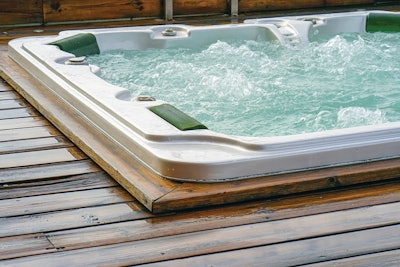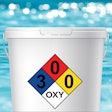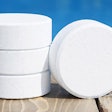
The pandemic generated a whole new segment of hot tub buyers, many of whom wanted to convert their COVID-canceled vacation plans into a year-round soaking strategy. They make up a whole new class of spa care neophytes, complete with their own info-vacuum on biofilm, clarity and other water maintenance challenges, the surmounting of which is crucial to the spa experience.
Even newbies understand the importance of killing microorganisms with sanitizer, but when it comes to the supporting roles of spa cleanliness — eradicating biofilm, for example — most are clueless. Even spa care professionals can overlook the importance of biofilm, says Jim Parker, owner of Unique Solutions. “I would say that eight of 10 customers that call me tell me their dealers have never once mentioned biofilm to them. Dealers don’t want to acknowledge that the problem exists, because they’re afraid it will scare off the customer."
A biofilm breaker is just one overlooked spa chemical — there are others, including borates and enzymes with phosphate remover — that get lost in the sales pitch to both new hot tub buyers and existing spa customers. Sanitizers, oxidizers and shock get all the attention, but spa chemical manufacturers contend buyers need to know upfront what else to expect. That way, there will be fewer water chemistry surprises along the way.
Gaining consumers’ trust is critical to long-term retail relationships, which in turn, help build a larger and more reliable customer base.
“Selling pH reducer and stainless scale control is not going to get you rich,” says John Bokor, director of sales for Haviland Pool and Spa Products. “But when a customer needs other things, they’re going to come to you. And when the customer is happy, they drive more sales through referrals. Their friends come over and sit in the hot tub, and they say, ‘Man this feels really good. The water’s so soft.’ Then the spa owner will send them your way. You want a customer’s business for the life of that spa, and for the ones the customer is going to buy after that, too.”
Biofilm Breakers
Biofilm forms when bacteria adhere to surfaces in moist environments by excreting a glue-like substance. That becomes a slippery layer of slime on the inside of tubing and piping and on other surfaces. Those layers of slime form the biofilm matrix, which resists incursion from your sanitizer and thus, provides a refuge for bacteria.
Biofilm comes in all colors and shades — blacks, browns, yellows, greens, reds, oranges — and can contain algae, fungi and mold as well as bacteria. Biofilm breakers act as a surfactant that breaks up the bad sanctuary so its components can be filtered, killed and/or oxidized.
“You might have thousands and thousands of layers of biofilm,” Parker says. “We just go in there and penetrate it, layer by layer. We puncture little holes throughout the matrix, and then the water pressure actually pushes it out. Chlorine, bromine, vinegar — people have tried all kinds of things — and they just simply don’t work. They can’t penetrate that outer epidermal layer.”
Experts recommend biofilm breakers be used to purge the hot tub’s plumbing at least every six months. They can work their magic over the course of 30 minutes or 24 hours, depending on the product. The key is educating spa owners about the perils of biofilm and explaining how they can beat it.
“Be 100% transparent with customers, and let them know this is an issue they’re going to run across,” Parker says. “Bacteria is going to grow in your hot tub, guaranteed. By being honest with customers, you’re saying this is going to happen, but we have a product that is going to eliminate the problem.”
Borates
Borates are anions composed of boron and oxygen, elements 5 and 8 on the periodic table, and they are useful for reducing the “pH creep” that naturally occurs in a hot tub. The chemical is also a natural chelator with calcium.
“In spas, where you have things like low-flow, 24-hour heating systems that run all the time, heating elements tend to scale up in spots — just like the water heater at your house,” he says. “Borate helps hold that calcium in the water, so that those heating elements don’t scale up as quickly. It saves you in the long run, because you’re not adding more chemicals that increase the total dissolved solids in the spa and make you drain it and refill it more frequently.”
While the chemical’s popularity has soared for use in swimming pools during the COVID era by helping stabilize water chemistry and reduce sanitizer consumption, Bokor says borate use in spas is often overlooked due to simple lack of awareness of its parallel benefits to hot water chemistry. In addition to its roles in pH buffering and calcium sequestration, he says, “It’s a softening mechanism, too. The water feels better, it feels softer. And with the added fragrance, it creates a pleasant smell; the hot tub doesn’t smell chemically anymore. That fragrance has nothing to do with the chemistry behind the product, but it does have to do with user comfort level. And at the end of the day, we want people to use their spas.”
Enzymes With Phosphate Remover
The increasing use of electrolytic generators in spas has prompted the introduction of a newer product to the market in the form of enzymes with phosphate removers. Phosphate enters the spa from a variety of sources, and can combine with calcium in the extreme chemistry of the electrolytic generator to form white, chalky flakes of calcium phosphonate that float in the water and annoy bathers.
“Enzymes themselves break down the yuck — all of the lotion, mascara and hair products that gum up your filter,” Bokor says. “If you use enzymes weekly, they break that stuff down all the time and reduce the amount of buildup. In spas, enzyme use is really more important than in a big swimming pool, because the body of water is much smaller. When you put, say, four people in a 400-gallon hot tub, that’s like putting 20 or 30 people in a 20,000-gallon pool. The amount of stuff that is coming off of people is huge. But while everyone is doing this combination of enzyme and phosphate removers for the pool, the hot tub side has been neglected.”
Again, making people aware of the need is key.
“This is new chemistry for the spa world,” Bokor says. “Phosphates will continue to be an issue moving forward, and the levels in municipal water need to be reduced, too. When you combine phosphate remover with an enzyme that everyone should be using, you get the best of both worlds. If you can help consumers have a better maintained spa, you can keep them excited about their hot tubs.”



































